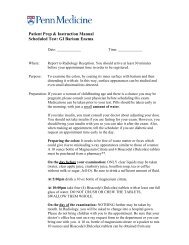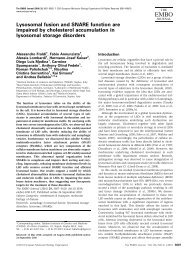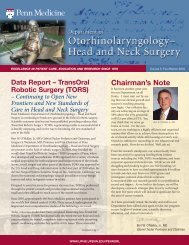Essentials of water treatment in hemodialysis - Penn Medicine
Essentials of water treatment in hemodialysis - Penn Medicine
Essentials of water treatment in hemodialysis - Penn Medicine
You also want an ePaper? Increase the reach of your titles
YUMPU automatically turns print PDFs into web optimized ePapers that Google loves.
Ahmad<br />
with DI and should be followed by ultrafiltration to<br />
remove bacterial fragments.<br />
WATER DELIVERY LOOP<br />
Purified <strong>water</strong> is run through the dialysis unit <strong>in</strong> a loop as<br />
shown <strong>in</strong> Figure 2, the term<strong>in</strong>al end <strong>of</strong> the loop end<strong>in</strong>g <strong>in</strong><br />
the pipe feed<strong>in</strong>g <strong>water</strong> <strong>in</strong>to the RO or DI unit. Dialysis<br />
mach<strong>in</strong>es are connected to this loop <strong>in</strong> parallel withdraw<strong>in</strong>g<br />
<strong>water</strong> for proportion<strong>in</strong>g with dialysate concentrate.<br />
The second arrangement is shown <strong>in</strong> Figure 6 where the<br />
purified <strong>water</strong> is delivered <strong>in</strong>to a hold<strong>in</strong>g tank from which<br />
the <strong>water</strong> is pumped <strong>in</strong>to the distribution loop that<br />
returns <strong>water</strong> back <strong>in</strong>to the tank.<br />
MATERIAL FOR PIPE AND FITTINGS<br />
Substances for <strong>water</strong> pipes and surfaces exposed to <strong>water</strong><br />
can leach <strong>in</strong> the <strong>water</strong> and have been known to cause<br />
toxicity <strong>in</strong> dialysis patients. For example, copper <strong>in</strong>toxication<br />
from copper pipes and the accumulation <strong>of</strong> alum<strong>in</strong>um<br />
dissolved <strong>in</strong> <strong>water</strong> has happened. It is therefore<br />
required, that all the <strong>water</strong> pipes <strong>in</strong> dialysis units should<br />
be free <strong>of</strong> metals and are constructed <strong>of</strong> polyv<strong>in</strong>ylchloride.<br />
Similarly, all the surfaces exposed to <strong>water</strong> such as<br />
storage tank or cas<strong>in</strong>gs <strong>of</strong> the devices should be constructed<br />
<strong>of</strong> materials that do not readily leach <strong>in</strong> the<br />
<strong>water</strong>.<br />
Dra<strong>in</strong><br />
R/O<br />
Dialysis Stations<br />
0.1-µm<br />
filter<br />
Storage<br />
Tank<br />
Pump<br />
0.1-µm<br />
filter<br />
Figure 6 Water loop connected to a storage tank.<br />
WATER QUALITY STANDARDS<br />
Even <strong>in</strong> the early days <strong>of</strong> dialysis it was known that s<strong>of</strong>t<br />
<strong>water</strong> should be used to avoid problems with excess Ca<br />
and Mg, the ‘‘hard <strong>water</strong> syndrome.’’ With time, the<br />
cl<strong>in</strong>ical syndromes associated with accumulations <strong>of</strong> various<br />
ions com<strong>in</strong>g from the <strong>water</strong> gradually forced tighter<br />
purity standards. Most dramatic and damag<strong>in</strong>g was the<br />
alum<strong>in</strong>um <strong>in</strong>toxications caus<strong>in</strong>g severe morbidity and<br />
even mortality. As we learn more about the harmful<br />
effects <strong>of</strong> less pure <strong>water</strong>, particularly with the use <strong>of</strong><br />
very permeable dialyzers, the purity standards are becom<strong>in</strong>g<br />
more str<strong>in</strong>gent. At present, the <strong>water</strong> purity standards<br />
can be divided <strong>in</strong> three broad categories:<br />
1 Standards for <strong>in</strong>organic solutes;<br />
2 Standards for microorganisms and other organics; and<br />
3 Standards for lipopolysaccharide and endotox<strong>in</strong>s.<br />
Standards for <strong>in</strong>organic solutes<br />
Table 2 describes the cl<strong>in</strong>ical effects <strong>of</strong> accumulation <strong>of</strong><br />
various <strong>in</strong>organic substances and the acceptable maximum<br />
concentrations <strong>in</strong> dialysis <strong>water</strong> (as recommended<br />
by Advancement <strong>of</strong> Medical Instrumentation [AAMI]).<br />
Evolution <strong>of</strong> knowledge about <strong>water</strong>-related cl<strong>in</strong>ical problems<br />
is quite <strong>in</strong>terest<strong>in</strong>g and <strong>of</strong>ten based on anecdotal<br />
experiences. Some <strong>of</strong> the important cl<strong>in</strong>ical issues would<br />
be discussed <strong>in</strong> the follow<strong>in</strong>g examples.<br />
Alum<strong>in</strong>um <strong>in</strong>toxication<br />
Outbreaks <strong>of</strong> unexpla<strong>in</strong>ed, progressive dementia <strong>of</strong>ten<br />
lead<strong>in</strong>g to death occurred <strong>in</strong> areas with significant alum<strong>in</strong>um<br />
contam<strong>in</strong>ation <strong>of</strong> local <strong>water</strong> supply. Also noted was<br />
the higher prevalence <strong>in</strong> units not us<strong>in</strong>g adequate <strong>water</strong><br />
purification systems. One <strong>of</strong> the most <strong>in</strong>terest<strong>in</strong>g <strong>in</strong>cidences<br />
occurred <strong>in</strong> Portugal <strong>in</strong> 1993, when city <strong>water</strong><br />
authorities decided to add alum<strong>in</strong>um sulfate as flocculent<br />
to remove particulate matters from the <strong>water</strong>. This subsequently<br />
led to HD patients develop<strong>in</strong>g dementia, and<br />
many deaths occurred. Subsequently, it was discovered<br />
that encephalopathy was caused by alum<strong>in</strong>um <strong>in</strong>toxication<br />
with blood levels as high as 500 mg/L (normal,<br />
















